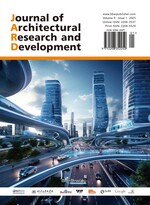Abstract
The preservation condition of historical buildings is closely related to their ventilation environment. This study focuses on the rock temples in Wudang Mountain, specifically comparing the ventilation conditions of Yinxian Rock and Huayang Rock. The following conclusions are drawn: (1) The main wind direction at Yinxian Rock aligns with its orientation, which is an easterly wind, while Huayang Rock experiences a westerly wind, deviating from its southwestern entrance; (2) Huayang Rock has significantly lower wind speeds compared to Yinxian Rock, with minimal airflow; (3) The surrounding environment of Huayang Rock features steep terrain, dense tree cover, and the presence of railings and other structures that impede wind entry into the cave, whereas Yinxian Rock is surrounded by fewer trees and has a flat terrain; (4) In terms of cave morphology, Yinxian Rock is completely open on the east side, while Huayang Rock’s opening accounts for only half of its area and is not directly aligned with the rock temple. In summary, Huayang Rock’s ventilation environment is inferior to that of Yinxian Rock, leading to more severe pathologies. It is inferred that Huayang Rock’s preservation issues are closely related to its poor ventilation environment. Therefore, improving its ventilation conditions is crucial for preventive conservation. Using environmental simulation, this study compares the ventilation conditions of Huayang Rock under different wind directions and speeds, identifies the two most ideal scenarios, and proposes several feasible solutions.
References
Huang K, 2018, Thoughts on Several Issues of Stone Cultural Relics Protection. Chinese Cultural Heritage, 04: 4–12.
Wang Z, 2020, Analysis of the Architectural issue Mechanism and Potential Hazards of “Water” on the Brick and Stone Architectural Heritage of Wudang Mountain, thesis, Huazhong University of Science and Technology.
Wang C, Chen M, Wang Y, 2023, Surface Flaking Mechanism of Stone Components of Ancient Building Complex in Wudang Mountain, China. Construction and Building Materials, 399: 132611.
Wang J, Yan Z, Wang X, et al., 2015, Experimental Study on Natural Ventilation of Caves in Mogao Grottoes, Dunhuang. Journal of Xi’an University of Architecture and Technology (Natural Science Edition), 47(05): 712–716.
Wang J, Yan Z, Wang X, et al., 2015, Research on Natural Ventilation Test of Mogao Grottoes. Dunhuang Research, 04: 121–126.
Wang J, Yan Z, 2020, Research on the Mechanism of Air Exchange Inside and Outside the Caves of Mogao Grottoes in Dunhuang. Building Science, 36(02): 140–147.
Wang J, 2016, Research on Ventilation Regulation and Control Technology of Mogao Grottoes in Dunhuang, thesis, Xi’an University of Architecture and Technology.
Zhou B, 2021, Analysis and Research on Natural Ventilation Characteristics of Maijishan Grottoes, thesis, Xi’an University of Architecture and Technology.
Zhu J, 2005, Collection of Hubei Architecture: World Cultural Heritage—Ancient Building Complex of Wudang Mountain. China Architecture & Building Press, Beijing.
Liu Z, 2020, Research on the Architectural Features and Genesis Analysis of the Brick and Stone Hall of Yinxian Rock in Wudang Mountain, thesis, Huazhong University of Science and Technology.
Song S, Wang D, Tian M, et al., 2022, Research on the Influence of Atmospheric Environment on the Architectural issue Mechanism of Stone Cultural Relics Sites. Journal of North China University of Science and Technology (Natural Science Edition), 2022, 44(03): 86–93.
Liu J, 2019, Research on the Architectural issues of Brick Cultural Relic Buildings in the Southeast Coastal Area, thesis, Harbin Institute of Technology.
Wan L, 2018, Research on the Mechanism of Cracking Architectural issues in Cultural Relic Buildings Under Dry and Wet Climate Environments, thesis, Huazhong University of Science and Technology.
Wang J, Chen J, Wang L, et al., 2022, Research on the Architectural issues and Types of Grotto Temples in China. Southeast Culture, 04: 25–32.
Zhang K, 2016, Research on Wind Environment Design of Green Industrial Buildings, thesis, Suzhou University of Science and Technology.
Ye C, 2018, Analysis of Effective Ventilation in Single-Sided Naturally Ventilated Buildings Driven by Wind Pressure, thesis, Wuhan University of Technology.
Hao M, Xu D, 2019, Discussion on Passive Natural Ventilation Design Methods for Green Buildings. Ju She, 28: 118.
Meng Y, 2022, Research on Physical Environment Control Technology of Longmen Grottoes Based on Weathering Mechanism of Cultural Relics, thesis, Xi’an University of Architecture and Technology.
Li Y, 2003, Technologies of Inducing, Guiding, and Creating Winds in Natural Ventilation of Buildings. Architectural Knowledge, 04: 17–20.
